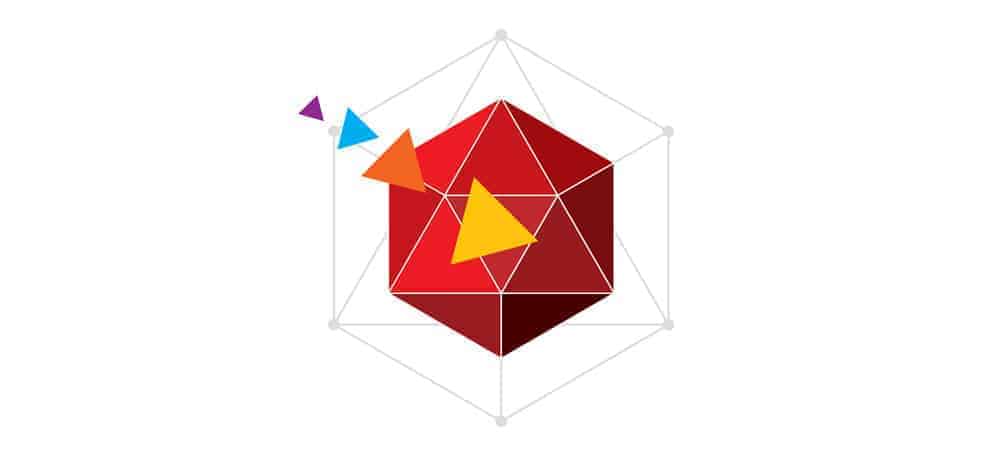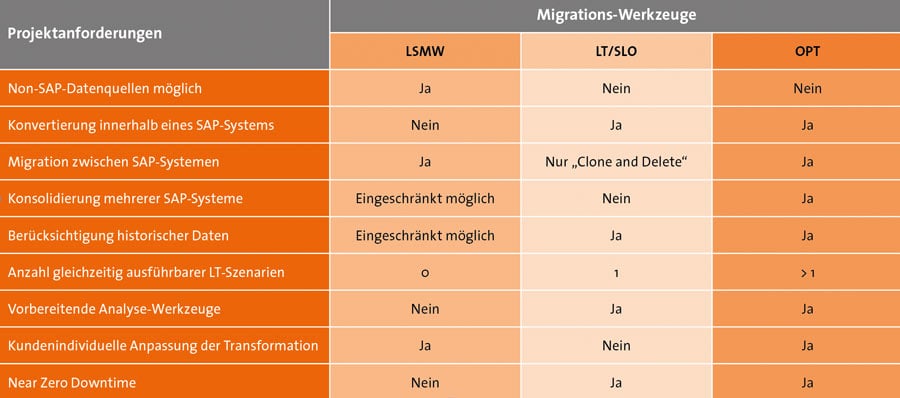SAP Object-based Transformation


Most SAP customers are familiar with the Legacy System Migration Workbench (LSMW) as an efficient tool for migrations or mass data changes. Interfaces predefined by SAP for the data transfer workbench, for batch input and direct input processing and for the standard BAPI and IDoc interfaces ensure consistent posting of all data.
Data is updated transactionally, i.e. the data made available for processing is checked against the current customizing or the validity of dependent objects, for example, in the same way as manual processing by users.
If data is to be transferred from external systems or existing SAP data objects are to be adapted or extended, LSMW remains the preferred and quick-to-use tool. However, if, for example, the data history or complete document chains are to be migrated, other tools must be used.
Landscape Transformation
The Landscape Transformation 2.0 (LT 2.0) software developed by SAP is now also well known in IT departments. SAP LT 2.0 has a large number of quality-tested and globally certified tools for the secure adaptation and conversion of current SAP systems.
So-called LT scenarios or specific SLO services are available especially for individual specific use cases. These use predefined and parameterizable functions and a clear conversion roadmap to ensure that all necessary work steps can be carried out chronologically and correctly.
The use of SAP Landscape Transformation 2.0 software requires the use of SAP-certified consultants. If the customer's requirement only consists of a content adjustment, for example a chart of accounts harmonization or the reorganization of profit centers, the LT 2.0 tools are the recommended transformation tool.
Carve-outs
But even in more complex scenarios, such as a carve-out of a part of a company (e.g. through a sale) in order to be subsequently transferred to a newly created SAP system on its own, the LT software helps quickly and reliably with the Clone and Delete scenario.
An SAP system is completely copied and, in a subsequent step, all company codes that are not to be transferred are deleted from the system copy. What remains is a system that can be used immediately with only the relevant company codes.
SAP Landscape Transformation 2.0 generally reaches its limits when the necessary transformation or consolidation requirements exceed the scope of the scenarios predefined by SAP.
The sequential stringing together of several LT scenarios, which is conceivable in theory, is also not practical because this automatically leads to long project runtimes and multiple testing efforts.
This is particularly the case if harmonizations and duplicate cleansing, reorganizations and conversions, renaming or mergers have to be carried out at the same time.

Selective data migration
SAP has another tool for these requirements, but one that is less familiar to most customers' specialist departments: SAP Object-based Transformation, or SAP OBT for short.
The main idea here is to transform related logical data objects, known as business objects, directly at the database table level. This makes it possible to migrate the entire data history of the individual objects.
Unlike transactional data migration using LSMW or the SAP Posting Engine, for example, OBT is referred to as selective data migration.
The basis for this is the Business Object Directory supplied by SAP at OBT, which already contains around 500 different business objects. A business object - classified as a main or sub-object - not only contains all associated SAP tables in the directory, but in particular also the intelligent linking to other business objects in order to enable a consistent structure of all associated data.
Despite the predefined 500 different business objects, the reality of projects often requires additional or modified business objects. Based on specific project requirements, Gambit Consulting has modeled a large number of additional business objects and thus significantly expanded the scope of SAP OBT.
The object modeling tools are also used to transfer customer-specific data objects easily and without restrictions.
SAP OBT enables both the transformation within a system (object-based conversion) and the transfer between two systems (object-based migration). The prerequisite is that the systems involved are SAP systems. Non-SAP-based systems are not supported by OBT.
Object-based migration
In an object-based migration, the scope is determined either by a complete transfer of all data from a source system or the targeted selection of data from specified organizational units (usually one or more company codes).
Transformation into a target system that is already in operational use is not a problem. Unlike traditional data migration, OBT transfers data at table level. This means that historical data as well as all processed transactions can be transferred without restriction and while retaining the complete document flow.
When transforming the data, the advantages of SAP OBT come into play thanks to the numerous customization options, such as process-related or structural optimizations.
These are among others:
- Renaming (company codes, controlling areas, material or personnel numbers)
- Mergers (company codes, controlling areas, cost centers or profit centers)
- Reorganization or conversion (asset classes, charts of accounts, cost centers, profit centers, fiscal year, debtors or creditors)
- Harmonization and duplicate cleansing (accounts receivable, accounts payable or materials)
Other adjustments include the controlling area currency, the operating concern currency and the introduction of a parallel currency.
Customer-specific parameterization
In preparation for projects in which the SAP OBT tool is to be used, functionally powerful analysis tools are used to help understand the customer-specific features in their SAP systems.
For example, comparisons in the areas of customizing, workbench or number ranges can be carried out at the touch of a button in order to directly identify potential areas for action. These analyses help to identify specific challenges at an early stage and coordinate them with the customer.
The specific requirements and the necessary transformations are summarized in blueprint documents. A major advantage of the SAP OBT tool is the minimal involvement of the specialist departments - if the existing business processes are not to be fundamentally changed. The blueprint documents then only describe the agreed data adjustments.
Everything else is then transformed one-to-one to the data source. The implementation and customer-specific parameterization of the OBT tools is carried out within a short time by a team of experienced consultants. Initial transformations into a test system can usually take place shortly after completion of the design phase.
To ensure a smooth and quality-tested go-live, at least two complete OBT runs are usually scheduled as tests. The knowledge gained during the tests ensures a smooth data changeover.
With appropriate project planning, the OBT enables near-zero downtime, even with extremely large data volumes. In addition to this virtually unrestricted business continuity, the availability of all historical data is another advantage of this tool.
Typical scenarios
The SAP OBT tool allows for a wide variety of transformation scenarios. However, the strengths of SAP OBT are particularly evident in the following typical applications:
Business Process Optimization, in which charts of accounts are standardized across the Group and heterogeneous master or control data can be comprehensively cleansed and revised.
System Consolidation to consolidate the number of SAP systems that has grown over time and adapt them to current requirements.
Corporate restructuring within a group of companies, in which entire organizational units (e.g. plants) can be reassigned across companies in SAP systems.
Post-merger integration using company code transfer, whereby all data of the acquired company can be moved from the seller's SAP system to the buyer's SAP system already in use and work can continue there without interruption.
S/4 Hana or Central Finance Preparation with the aim of preparing the current SAP system landscape for the changeover to SAP S/4 Hana and creating an optimized structure for modern SAP applications.
Advantages of SAP Object-based Transformation (OBT):
- Compared to traditional migration projects, OBT projects can be completed in less time and with less effort for the specialist departments.
- The complete data history can only be transferred during migrations if SAP OBT is used. Business continuity is ensured by providing the complete document flow (regardless of whether it is closed, processed or open).
- The customizability of the transformation rules in object-based transformation enables almost any optimization of all data in one step (!). It does not matter whether it is a matter of reorganizations, mergers, harmonizations, renaming or other adjustments.
- OBT enables trouble-free and uninterrupted transformation and therefore near-zero downtime even with very large data volumes.
- If, for example, a large number of different SAP systems are to be repeatedly consolidated in one system, the use of the adapted OBT tool can be "industrialized", with corresponding savings in terms of costs and time in the rollouts.






